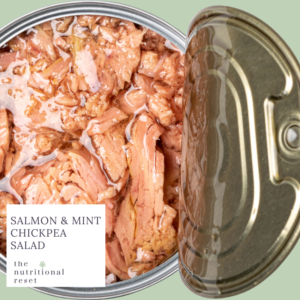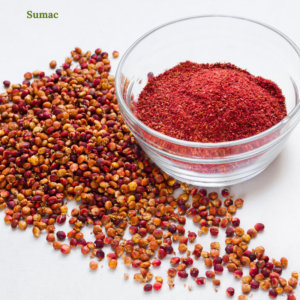 Clients often ask me for time-saving tips to prep healthy meals fast. Personally, when it comes to lunch, I rely on canned fish and canned beans. This Salmon & Mint Chickpea Salad, which uses both, is just one of the recipes in my rotation. Why canned fish and canned beans? Besides being quick to prepare, they are:
Clients often ask me for time-saving tips to prep healthy meals fast. Personally, when it comes to lunch, I rely on canned fish and canned beans. This Salmon & Mint Chickpea Salad, which uses both, is just one of the recipes in my rotation. Why canned fish and canned beans? Besides being quick to prepare, they are:
- minimally processed,
- easy to keep on hand in the pantry,
- relatively inexpensive,
- excellent sources of protein and
- very versatile.
This salad’s a cinch to whip up, is easily portable and keeps in an airtight container for up to three days. There is no meal faster than a leftover salad – you don’t even need to reheat it!
And if your garden is currently overgrown with mint like mine, this is a delicious way to use up some of it. No mint? No problem. Just sub in parsley or another favourite fresh herb such as chives. As with any salad, feel free to add other veggies you like too. Bell peppers, green onions and radishes are all tasty, healthy and colourful additions.
Sign up to my newsletter today to receive the Salmon & Mint Chickpea Salad recipe. And read on for more about the health benefits of this simple and delicious salad.
How healthy is this salad? Let me count the ways…
- Heart Health – This salad is rich in heart-healthy fats from the extra virgin olive oil and wild salmon. These are monounsaturated and polyunsaturated fats which can help to lower levels of harmful cholesterol and reduce your risk of heart disease. And it provides a good amount of dietary fiber from the chickpeas, which can also help to control cholesterol levels.
- Bone Health – The wild salmon in this recipe is a good source of Vitamin D, essential for the absorption of calcium and phosphorous (nutrients that are crucial for maintaining healthy bones). And if you purchase canned salmon with the bones and keep the small soft bones in, it’s a great way to increase the amount of calcium you consume.
- Immune Health – The lemon and red onion in the recipe are good sources of Vitamin C, a nutrient that plays a crucial role in supporting the immune system. And, the wild salmon provides a good amount of selenium, a mineral that also helps to boost the immune system.
A sidenote on sumac
 Sumac is the one item in the ingredient list which may not be familiar so I thought a sidenote would be in order. Sumac spice is the dried and ground red berry of the sumac plant. Note that this plant is from the same plant family that cashews come from, so if you’re allergic to cashews or other foods in the cashew family (e,g., pistachios, mangoes or pink peppercorns), you’d be wise to avoid consuming sumac.
Sumac is the one item in the ingredient list which may not be familiar so I thought a sidenote would be in order. Sumac spice is the dried and ground red berry of the sumac plant. Note that this plant is from the same plant family that cashews come from, so if you’re allergic to cashews or other foods in the cashew family (e,g., pistachios, mangoes or pink peppercorns), you’d be wise to avoid consuming sumac.
Sumac is commonly used in Middle Eastern cooking and is a key ingredients in za’atar, which is becoming increasingly popular. Sumac has a complex flavour with tart, lemony, floral and earthy notes. If you don’t have sumac, just add a little more lemon or some lime (or even za’atar if you have it). But sumac is a worthy addition to your spice rack. It adds a lively acidic lift to a lot of foods, both savory and sweet. Besides salads like this, I use it on grilled or roasted meats and vegetables or sprinkle it on hummus. I also use it to garnish Greek yogurt and honey with some sliced pears, apricots or figs for a simple dessert.